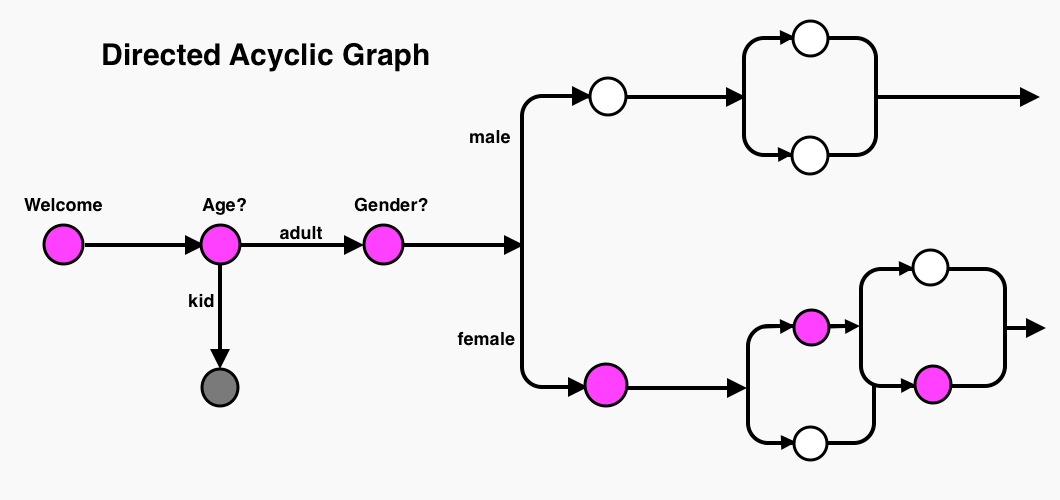GraphFlow is a lightweight library for designing 'logic based' UI flows. You create a graph of nodes logically connected where each node represents a UI renderable object (fragment/view/whatever).
Per module:
- :core: 9
- :fragments: 9
- :views: 14
- :conductor: 16
This library was heavily influenced by a Reddit Post
Add dependencies in your build.gradle
dependencies {
// Core library.
compile "com.saantiaguilera.graphflow:core:<latest_version>"
// For using it with fragments. Brings support-fragments
compile "com.saantiaguilera.graphflow:fragments:<latest_version>"
// For using it with views
compile "com.saantiaguilera.graphflow:views:<latest_version>"
// For using it with conductor
compile "com.saantiaguilera.graphflow:conductor:<latest_version>"
}-
Create a
Graphwith nodes and connections. Lets say we have a signup application where:a. You set your name
b. You set your age
c. If you are <18 you validate something, else skips this
d. You set your email
// For this example I'll be using the View component (using fragments its the same but MView.class -> MFragment.class
// Create the type of graph, for this example we use a shipped in DirectedAcyclicGraph
Graph graph = new DirectedAcyclicGraph();
// Create the name input node
Node nameNode = new Node(NameInputView.class, new NodeSelector() {
@Override
public boolean select(@Nullable final Bundle args) {
return true; // Always pick it, its the root?
}
});
// Create the age input node
Node ageNode = new Node(AgeInputView.class, new NodeSelector() {
@Override
public boolean select(@Nullable final Bundle args) {
return true; // Always pick it if coming from the name.
}
});
// Create the under 18 input node
Node underEighteenNode = new Node(UnderEighteenView.class, new NodeSelector() {
@Override
public boolean select(@Nullable final Bundle args) {
return args.getInteger("age") < 18;
}
});
// Create the email input node
Node emailNode = new Node(EmailInputView.class, new NodeSelector() {
@Override
public boolean select(@Nullable final Bundle args) {
return true; // Always pick, doesnt matter from where you come
}
});
// Add the nodes to the graph, the order doesnt mind, when connected the shape will be formed.
graph.add(emailNode);
graph.add(underEighteenNode);
graph.add(ageNode);
graph.add(nameNode);
// Connect them as we want. We will do it like this:
// Name --> age --> underEighteen --> email
// \_________________/
graph.connect(name, age);
graph.connect(age, underEighteen);
graph.connect(age, email);
graph.connect(underEighteen, email);
// Graph done!- Create a node switcher! Node switcher is the class in charge of switching a node for another and make them "rendereable"
// Following the example, we will use a NodeViewSwitcher. If using fragments it would be the same with NodeFragmentSwitcher
NodeSwitcher<View> nodeSwitcher = new NodeViewSwitcher(activityContext, R.id.viewgroup_container_id);- Finally, create a router and start using it!
router = Router.<View>create()
.with(graph)
.switcher(nodeSwitcher)
.build();The router is the class in charge of managing the whole graph flow. The router provides a lot of useful methods:
-
fromRoot: Starts the graph from the root node. The root node is considered the only point with no incoming edges and >1 outgoing edges.
-
addOnNodeCommitListener: Adds a listener that will be triggered everytime we move from one node to another.
-
removeOnNodeCommitListener: Removes a listener, since they are kept as strong references.
-
next: Moves to the immediate node in the graph that fulfills the bundle params
-
back: Moves to the previous node
-
jump: Jumps to a given node
This library supports proguard transitively, no need to add extra rules :)
Feel free to submit me issues or fork it and do pull requests with changes!

